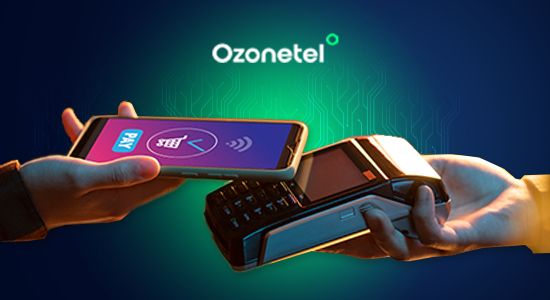- Resources
- Voice Bots vs. IVR: Key Differences, Benefits & Future Trends
Voice Bots vs. IVR: Key Differences, Benefits & Future Trends

Businesses rely on automated voice solutions to streamline customer interactions, reduce wait times, and manage high call volumes. While IVRs (Interactive Voice Response) have been the traditional choice, AI-powered Voicebots are reshaping how businesses handle customer queries.
The key challenge is knowing which solution aligns better with your business needs—whether it’s efficiently routing calls or providing human-like, real-time conversations. This comparison breaks down the core differences, limitations, and ideal use cases of IVRs and voicebots, helping you make an informed decision.
What Is Customer Obsession?
Customer obsession is about placing your customers at the core of every decision you make. It goes beyond simply satisfying their needs—it’s about actively working to improve their experience at every touchpoint, anticipating what they want, and addressing their concerns before they even raise them.
What is IVR?
Interactive Voice Response (IVR) is an automated system that interacts with callers using pre-recorded voice prompts and keypad inputs. It helps businesses manage high call volumes by directing customers to the right department or providing self-service options without the need for a live agent.
Benefits of IVR
Some benefits of implementing IVR are:
- Reduces Call Handling Time: IVR allows customers to navigate menus and get answers without speaking to an agent. This speeds up resolutions and reduces call wait times.
- Improves Call Routing: With IVR, callers are directed to the right department based on their inputs. This reduces misrouted calls and helps agents handle relevant queries efficiently.
- Available 24/7: IVR systems operate around the clock, allowing customers to get information or perform simple tasks (such as checking account balances or booking appointments) even outside business hours.
- Lowers Operational Costs: By handling repetitive queries, IVR reduces the workload on agents. Businesses need fewer agents for basic inquiries, leading to cost savings in staffing and training.
- Supports Multiple Languages: Many IVR systems offer language options, making customer service accessible to a wider audience. This is especially useful for businesses serving diverse customer bases.
- Integrates with Other Systems: IVR can connect with CRM (Customer Relationship Management) tools and databases to fetch real-time information. This allows customers to get personalized responses based on their account details.
What are Voicebots?
Voicebots are AI-powered systems that interact with customers over voice calls without human intervention. They use speech recognition and natural language processing (NLP) to understand queries and respond in real time. Unlike IVR (Interactive Voice Response), which relies on pre-recorded menu options, voicebots engage in two-way conversations, making interactions more efficient.
Benefits of Voicebots
Some benefits of implementing voicebots are:
- Handles High Call Volumes: Voicebots manage thousands of calls simultaneously, reducing wait times and improving service availability without adding more agents.
- Automates Repetitive Tasks: Routine queries like appointment scheduling, payment reminders, and order tracking can be handled by voicebots, freeing up agents for more complex issues.
- Reduces Operational Costs: By handling repetitive queries, voicebots help businesses reduce dependency on large customer support teams. Muthoot Finance, for instance, integrated a voicebot for payment reminders, improving collection rates while reassigning agents to other tasks.
- Provides Real-Time Analytics: Voicebots analyze customer conversations to identify patterns, sentiment, and areas for improvement. This helps businesses refine their service strategies based on real-time insights.
- Supports Multiple Languages: Many voicebots process conversations in regional languages, improving accessibility for diverse customer bases. National Health Authority (NHA) leverages voicebots that understand 11 vernacular languages, allowing healthcare advisors to serve patients more effectively.
- Works Round the Clock: Voicebots operate 24/7, handling customer inquiries outside business hours. This is especially useful for industries like healthcare, e-commerce, and banking, where timely responses are crucial.
IVR vs Voicebots: Core Differences
Choosing between IVR (Interactive Voice Response) and Voicebots requires a clear understanding of how they function. While both automate customer interactions, they differ in user experience, response capability, and overall efficiency.
IVRs rely on pre-recorded menus and keypad inputs, whereas Voicebots use AI and NLP (Natural Language Processing) to understand and respond to natural speech.
Below is a detailed comparison of their core differences.
| Feature | IVRs | Voicebots |
|---|---|---|
| Customer Experience | Menu-based, rigid navigation | Free-flowing, conversational |
| Contextual Responses | Generic, pre-recorded | Personalized, AI-driven |
| Handling Complex Queries | Limited capabilities | Advanced problem-solving |
| Sales Capabilities | Passive, minimal upselling | Proactive, personalized recommendations |
| Call Navigation | Touch-tone inputs | Speech recognition |
| Multilingual Support | Manual selection | Automatic language detection |
| Call Abandonment | High due to frustration | Low with real-time responses |
| Cost Efficiency | Higher cost per call | Lower cost due to automation |
1. Customer Experience
IVRs operate on structured menu-based navigation, requiring customers to listen to a series of options and press corresponding keys to proceed. This rigid structure often leads to frustration when the available options do not match the query, forcing users to either restart the process or wait for an agent. For instance, a bank’s IVR might require multiple steps before a customer can check loan eligibility, making the interaction time-consuming.
Voicebots eliminate this issue by allowing natural, conversational interactions. Instead of pressing buttons, customers can simply speak their requests, and the Voicebot will understand and respond accordingly. If a customer asks about loan eligibility, a Voicebot can process the request immediately, provide relevant information, and even check the user’s history to offer personalized assistance. This streamlined experience reduces friction and ensures customers get answers faster.
2. Contextual Responses
IVRs deliver pre-recorded, one-size-fits-all responses, limiting their ability to handle queries that require dynamic or personalized answers. If a customer asks a question outside the IVR’s programmed script, the system either provides a generic response or routes the call to a live agent. This lack of adaptability can lead to repetitive interactions and longer resolution times.
Voicebots, on the other hand, use AI-powered contextual understanding to provide tailored responses. They can remember past interactions, recognize returning customers, and adjust replies based on user intent. For example, if a customer calls about an ongoing service request, the Voicebot can acknowledge prior conversations and offer an update without requiring the caller to repeat details. This makes interactions more relevant and significantly reduces call handling time.
3. Handling Complex Queries
IVRs are best suited for simple, transactional tasks like checking account balances, scheduling appointments, or directing calls to the right department. However, they struggle with multi-step or complex inquiries that require logical reasoning. For instance, if a customer calls an IVR to ask about business loan requirements, the system can only provide a fixed list of documents but cannot assess the customer’s specific situation.
Voicebots excel at handling detailed and multi-layered conversations. They can analyze customer input, retrieve relevant data, and provide specific answers without transferring the call. If a customer inquires about a loan, a Voicebot can check eligibility criteria, compare interest rates, and guide the caller through the application process in one seamless conversation. This ability to handle end-to-end interactions reduces dependency on human agents while improving efficiency.
4. Sales and Upselling
IVRs primarily function as automated call routers, offering minimal engagement beyond providing basic information. They lack the intelligence to identify sales opportunities or suggest personalized offers, making them ineffective for upselling or customer retention. A telecom company’s IVR, for example, might provide plan details but cannot proactively recommend a better plan based on a customer’s usage history.
Voicebots, however, use AI-driven insights to identify sales opportunities and suggest relevant products or services. If a customer frequently exceeds their mobile data limit, a Voicebot can recommend an upgraded plan at a discounted rate. Similarly, in e-commerce, a Voicebot can recognize past purchases and suggest complementary products, increasing the likelihood of conversion. This proactive approach helps businesses drive more revenue without human intervention.
5. Call Navigation
IVRs require users to press buttons to navigate through menus, which can be cumbersome and slow. If a caller selects the wrong option, they often have to start over, leading to frustration and increased call abandonment rates. Moreover, IVRs are ineffective in handling open-ended queries, as they depend on predefined menu structures.
Voicebots, in contrast, allow hands-free, voice-driven interactions. Instead of pressing 1 for billing or 2 for support, customers can simply say, “I need help with my bill”, and the Voicebot will process the request instantly. This natural interaction speeds up resolution, eliminates unnecessary steps, and enhances user satisfaction.
6. Multilingual Support
IVRs require customers to manually select their preferred language at the beginning of the call. If the wrong language is chosen, the user has to restart the process, leading to inconvenience. Additionally, most IVRs offer limited language support, making them inaccessible to diverse customer bases.
Voicebots provide real-time language detection and seamless switching between languages within a single conversation. A customer can begin speaking in English and switch to Spanish mid-call, and the Voicebot will continue understanding and responding accordingly. This adaptive multilingual support improves accessibility, making customer service more inclusive.
7. Call Abandonment Rates
IVRs are known for high call drop rates due to their lengthy menu structures and slow navigation. Customers who struggle to find the right option often hang up before resolving their issue, increasing frustration and reducing customer satisfaction. A user calling tech support through an IVR, for instance, may abandon the call if they have to go through multiple steps just to reach a representative.
Voicebots significantly reduce abandonment rates by providing immediate responses and resolving issues faster. Since users can speak naturally without navigating rigid menus, they are more likely to stay engaged throughout the call. This improves customer retention and first-call resolution rates, leading to better service efficiency.
8. Cost Per Resolution
IVRs require significant human intervention, as they often redirect calls to agents for anything beyond basic inquiries. This increases operational costs, particularly for businesses handling high call volumes. Since IVRs lack AI-driven automation, they cannot independently resolve complex issues, leading to longer wait times and higher staffing costs.
Voicebots drastically reduce the cost per resolution by handling a larger portion of queries without human involvement. AI-powered bots can answer detailed questions, process requests, and even perform transactions without needing an agent. For example, an e-commerce company using a Voicebot for order tracking and cancellations can handle thousands of customer inquiries without additional staff, resulting in substantial cost savings.
Voicebots or IVR: What’s best for your business
Choosing between voicebots and IVRs depends on your business needs, the complexity of customer interactions, and financial considerations. While IVRs are reliable for structured call routing, voicebots offer AI-driven conversational capabilities. Here’s a breakdown to help you decide.
Business Needs and Goals
If your business handles simple, high-volume queries, an IVR may be the better choice. It efficiently directs calls and provides pre-recorded answers to FAQs, reducing agent workload. However, if customer interactions require detailed, personalized responses, a Voicebot is more effective. Powered by AI and NLP (Natural Language Processing), Voicebots can understand intent, provide dynamic answers, and engage users in natural conversations.
Cost Considerations
IVRs are typically cheaper to implement and maintain, making them ideal for businesses with limited budgets. However, they may lead to higher call abandonment rates if customers find menu navigation frustrating. In contrast, voicebots require a higher upfront investment but can lead to cost savings over time by improving self-service resolution rates and reducing dependence on live agents.
Scalability
IVRs are static and can struggle when a business expands or customer queries become more diverse. Voicebots, however, learn and improve over time, making them a more scalable option for businesses expecting growth in customer interactions and service complexity.
Customer Preferences and Behavior
Understanding how your customers prefer to interact with your business is crucial. Some audiences prefer the structured simplicity of IVRs, especially for straightforward tasks like bill payments or appointment scheduling. Others expect the convenience of an AI-driven voicebot that can handle personalized requests, troubleshoot issues, or provide complex answers.
Best Use Cases for Each Technology
IVRs Work Best For:
- Call routing (e.g., directing callers to departments)
- Handling high-volume, repetitive queries
- Budget-conscious businesses needing a cost-effective solution
- Simple tasks like account balance inquiries or service activation
In contrast, voicebots work best in:
- Industries requiring personalized, dynamic conversations (e.g., healthcare, finance)
- Businesses handling complex queries and troubleshooting
- Companies prioritizing customer experience and self-service resolution
- Reducing call center load by handling inquiries effectively
Limitations to using IVR & Voicebots
While IVRs and Voicebots streamline customer interactions, they come with certain limitations that can impact efficiency and user experience. Understanding these drawbacks helps businesses make informed decisions when implementing automated solutions.
IVR Limitations
Some limitations of IVRs include:
- Frustrating User Experience: IVRs operate on fixed menu structures, which often force customers to listen to long lists of options before reaching the desired department. If a caller selects the wrong option, they must start over, leading to frustration and increased call abandonment.
- Limited Understanding of User Intent: Since IVRs depend on pre-recorded responses, they struggle to handle open-ended or complex queries. If a customer’s request does not fit within the predefined menu, the IVR either loops back or transfers the call to a live agent, delaying resolution.
- High Call Abandonment Rates: Customers dislike rigid and slow navigation, leading many to hang up before their issue is resolved. IVRs that require multiple steps before reaching a human agent can drive up abandonment rates, negatively impacting customer satisfaction.
- Lack of Personalization: IVRs do not remember past interactions, making them inefficient for repeat callers. A customer who previously called about a billing issue must go through the same process each time, instead of receiving personalized assistance based on history.
- Ineffective for Sales and Upselling: IVRs are static and reactive, meaning they cannot analyze customer needs or suggest relevant services. Unlike AI-driven solutions, IVRs lack the ability to proactively recommend upgrades or personalized offers.
Voicebot Limitations
Similarly, some drawbacks of using voicebots are:
- Accuracy Issues with Speech Recognition: While Voicebots use AI and NLP (Natural Language Processing) to understand human speech, they can still misinterpret words due to accents, background noise, or unclear pronunciation. This can lead to incorrect responses and frustration.
- Limited Handling of Highly Complex Issues: Voicebots are effective for structured conversations but may struggle with multi-layered problems that require critical thinking or human judgment. If a customer has an unusual request that does not align with the Voicebot’s training data, the system may provide irrelevant answers or require human intervention.
- Dependency on AI Training and Data Quality: Voicebots rely on continuous learning to improve accuracy. If the AI is trained on limited or poor-quality data, the bot may struggle to provide accurate responses, making interactions unreliable. Businesses must invest in ongoing AI training and updates to ensure optimal performance.
- Limited Emotional Intelligence: Unlike human agents, Voicebots lack empathy and emotional awareness. While they can detect sentiment using AI, they cannot fully adapt to emotions the way a human can. This makes them less effective for handling sensitive customer issues, such as complaints or escalations.
- Integration Challenges: Implementing a Voicebot requires seamless integration with CRM, ticketing systems, and databases. If the integration is incomplete or poorly executed, the bot may not have access to customer history, leading to ineffective interactions and a disjointed customer experience.
Future Trends in IVR & Voicebots
As customer service technology advances, both IVRs and Voicebots are evolving to improve efficiency, reduce customer frustration, and enhance self-service capabilities. Businesses are increasingly adopting AI-powered solutions to offer faster, more intuitive interactions. Here are the key trends shaping the future of IVRs and Voicebots.
1. Emotion & Sentiment Analysis
Future Voicebots will use AI-driven sentiment analysis to detect frustration, confusion, or urgency in a caller’s voice. This will help businesses prioritize escalations, adjust tone, or seamlessly transfer complex queries to live agents while maintaining a smooth customer experience.
2. Voice-Enabled Self-Service Portals
Instead of relying solely on agents, businesses will implement voice-enabled self-service solutions where customers can check order statuses, reset passwords, or troubleshoot issues through Voicebots without human intervention. This will significantly reduce call center workloads and improve resolution speed.
3. Voice Biometrics for Security & Authentication
As fraud risks grow, businesses will integrate voice biometrics for secure customer authentication. Instead of using PINs or passwords, customers will verify their identity through voice recognition, making interactions more secure and seamless.
4. Hybrid Systems Combining IVRs & AI Voicebots
Many businesses will blend IVRs and AI Voicebots to create hybrid solutions. IVRs will handle basic call routing, while AI-powered Voicebots will step in for more complex interactions. This hybrid approach will balance cost-efficiency with advanced automation.
5. Multilingual & Regional Language Support
Businesses are expanding globally, and multilingual voice interactions are becoming essential. Future Voicebots and IVRs will support regional dialects and multiple languages within a single conversation, improving accessibility and customer satisfaction across diverse demographics.
Voice Bots vs. IVR: Key Takeaways
Choosing between IVRs and Voicebots depends on your business needs, customer expectations, and budget. IVRs are effective for structured call routing and high-volume simple queries, while Voicebots offer AI-driven, conversational support for complex interactions. A hybrid approach combining both can maximize efficiency and customer satisfaction.
With Ozonetel’s AI-powered Voicebots and advanced IVR solutions, you can automate customer interactions, improve response times, and reduce operational costs—all while delivering seamless, personalized experiences. The right solution ensures faster resolutions, lower call abandonment rates, and a more engaged customer base.
Conclusion: How Ozonetel Can Help
Building a customer-first culture requires the right tools to support seamless communication, real-time insights, and personalized interactions. Ozonetel’s cloud communication solutions help businesses streamline customer interactions, improve response times, and enhance overall customer satisfaction.
With features like:
- Omnichannel communication to connect with customers across voice, chat, email, and social platforms.
- AI-driven analytics to track customer sentiment and improve service quality.
- Intelligent call routing to reduce wait times and connect customers with the right agents faster.
- Automated follow-ups and self-service options to ensure customer concerns are addressed promptly.
IVR or Voice Bots? Find the Best Solution for Your Contact Center
Frequently Asked Questions
Adopting a customer-first approach requires structural and cultural shifts within a company. Some common challenges include:
- Siloed Departments: Lack of coordination between sales, support, and product teams can lead to inconsistent customer experiences.
- Slow Response Time: If customer queries are not addressed quickly, satisfaction drops.
- Inflexible Policies: Rigid return, refund, or service policies may frustrate customers.
- Lack of Personalization: Treating all customers the same can reduce engagement.
- Measuring Customer Sentiment: Many businesses don’t track customer satisfaction effectively.
To assess how well your company prioritizes customers, track these key metrics:
- Net Promoter Score (NPS): Measures how likely customers are to recommend your business.
- Customer Satisfaction Score (CSAT): Captures immediate satisfaction levels after interactions.
- Customer Retention Rate: Indicates how well you keep existing customers.
- Customer Churn Rate: Tracks the percentage of customers who stop using your services.
- First Response Time (FRT): Measures how quickly customer queries are addressed.
- Customer Lifetime Value (CLV): Shows the total revenue a business can expect from a single customer over time.
Ozonetel is reshaping customer experience by integrating cloud-based communication solutions that offer features such as:
- Omnichannel Support: Unifying voice, chat, email, and social media interactions for seamless customer service.
- AI-Powered Analytics: Using AI to track customer sentiment and predict behavior for proactive service.
- Automation & IVR (Interactive Voice Response): Reducing wait times and improving first-call resolution with intelligent call routing.
- Remote & Hybrid Support Solutions: Allowing customer service teams to operate efficiently from anywhere.







